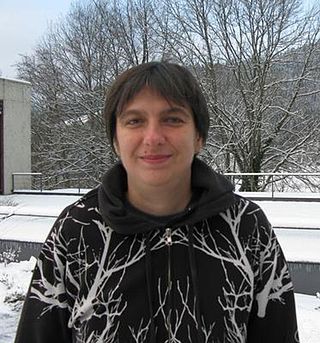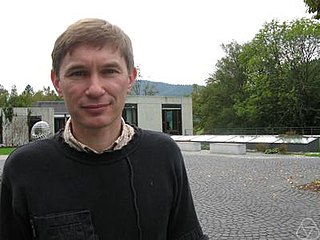Related Research Articles
In theoretical physics, twistor theory was proposed by Roger Penrose in 1967 as a possible path to quantum gravity and has evolved into a widely studied branch of theoretical and mathematical physics. Penrose's idea was that twistor space should be the basic arena for physics from which space-time itself should emerge. It has led to powerful mathematical tools that have applications to differential and integral geometry, nonlinear differential equations and representation theory, and in physics to general relativity, quantum field theory, and the theory of scattering amplitudes. Twistor theory arose in the context of the rapidly expanding mathematical developments in Einstein's theory of general relativity in the late 1950s and in the 1960s and carries a number of influences from that period. In particular, Roger Penrose has credited Ivor Robinson as an important early influence in the development of twistor theory, through his construction of so-called Robinson congruences.
Noncommutative geometry (NCG) is a branch of mathematics concerned with a geometric approach to noncommutative algebras, and with the construction of spaces that are locally presented by noncommutative algebras of functions, possibly in some generalized sense. A noncommutative algebra is an associative algebra in which the multiplication is not commutative, that is, for which does not always equal ; or more generally an algebraic structure in which one of the principal binary operations is not commutative; one also allows additional structures, e.g. topology or norm, to be possibly carried by the noncommutative algebra of functions.
In algebraic geometry and theoretical physics, mirror symmetry is a relationship between geometric objects called Calabi–Yau manifolds. The term refers to a situation where two Calabi–Yau manifolds look very different geometrically but are nevertheless equivalent when employed as extra dimensions of string theory.
The mathematical term perverse sheaves refers to the objects of certain abelian categories associated to topological spaces, which may be a real or complex manifold, or more general topologically stratified spaces, possibly singular.
Hilbert's fifteenth problem is one of the 23 Hilbert problems set out in a list compiled in 1900 by David Hilbert. The problem is to put Schubert's enumerative calculus on a rigorous foundation.

Arthur Michael Jaffe is an American mathematical physicist at Harvard University, where in 1985 he succeeded George Mackey as the Landon T. Clay Professor of Mathematics and Theoretical Science.

Jürg Martin Fröhlich is a Swiss mathematician and theoretical physicist. He is best known for introducing rigorous techniques for the analysis of statistical mechanics models, in particular continuous symmetry breaking, and for pioneering the study of topological phases of matter using low-energy effective field theories.
Categorical quantum mechanics is the study of quantum foundations and quantum information using paradigms from mathematics and computer science, notably monoidal category theory. The primitive objects of study are physical processes, and the different ways that these can be composed. It was pioneered in 2004 by Samson Abramsky and Bob Coecke. Categorical quantum mechanics is entry 18M40 in MSC2020.
Nikita Alexandrovich Nekrasov is a Russian mathematical and theoretical physicist at the Simons Center for Geometry and Physics and C.N.Yang Institute for Theoretical Physics at Stony Brook University in New York, and a Professor of the Russian Academy of Sciences.

Matilde Marcolli is an Italian and American mathematical physicist. She has conducted research work in areas of mathematics and theoretical physics; obtained the Heinz Maier-Leibnitz-Preis of the Deutsche Forschungsgemeinschaft, and the Sofia Kovalevskaya Award of the Alexander von Humboldt Foundation. Marcolli has authored and edited numerous books in the field. She is currently the Robert F. Christy Professor of Mathematics and Computing and Mathematical Sciences at the California Institute of Technology.
Mathematics is a field of study that investigates topics such as number, space, structure, and change.

Richard Paul Winsley Thomas is a British mathematician working in several areas of geometry. He is a professor at Imperial College London. He studies moduli problems in algebraic geometry, and ‘mirror symmetry’—a phenomenon in pure mathematics predicted by string theory in theoretical physics.
Mathematics is a broad subject that is commonly divided in many areas that may be defined by their objects of study, by the used methods, or by both. For example, analytic number theory is a subarea of number theory devoted to the use of methods of analysis for the study of natural numbers.
Urs Schreiber is a mathematician specializing in the connection between mathematics and theoretical physics and currently working as a researcher at New York University Abu Dhabi. He was previously a researcher at the Czech Academy of Sciences, Institute of Mathematics, Department for Algebra, Geometry and Mathematical Physics.
Sheldon H. Katz is an American mathematician, specializing in algebraic geometry and its applications to string theory.

Victor Vadimovich Batyrev is a Russian mathematician, specializing in algebraic and arithmetic geometry and its applications to mathematical physics. He is a professor at the University of Tübingen.

Ralph Martin Kaufmann is a German mathematician working in the United States.
Gabriele Vezzosi is an Italian mathematician, born in Florence, Italy. His main interest is algebraic geometry.

Kyōji Saitō is a Japanese mathematician, specializing in algebraic geometry and complex analytic geometry.

Alexander A. Voronov is a Russian-American mathematician specializing in mathematical physics, algebraic topology, and algebraic geometry. He is currently a Professor of Mathematics at the University of Minnesota and a Visiting Senior Scientist at the Kavli Institute for the Physics and Mathematics of the Universe.
References
- ↑ Margaret Osler (2010) Reconfiguring the World, chapter 5: Shifting boundaries: from mixed mathematics to mathematical physics, pages 94 to 117, The Johns Hopkins University Press ISBN 0-8018-9656-8
- ↑ Alexander Macfarlane (1885) Physical Arithmetic via Internet Archive
- ↑ Andrew Warwick (2003) Masters of Theory: Cambridge and the Rise of Mathematical Physics , pages 114,5,9, University of Chicago Press
- ↑ Gregory W. Moore. "Physical Mathematics and the Future" (PDF). Physics.rutgers.edu. Retrieved 2016-04-03.
- Eric Zaslow, Physmatics, arXiv : physics/0506153
- Arthur Jaffe, Frank Quinn, "Theoretical mathematics: Toward a cultural synthesis of mathematics and theoretical physics", Bulletin of the American Mathematical Society 30: 178-207, 1994, arXiv : math/9307227
- Michael Atiyah et al., "Responses to Theoretical Mathematics: Toward a cultural synthesis of mathematics and theoretical physics, by A. Jaffe and F. Quinn", Bull. Am. Math. Soc. 30: 178-207, 1994, arXiv : math/9404229
- Michael Stöltzner, "Theoretical Mathematics: On the Philosophical Significance of the Jaffe-Quinn Debate", in: The Role of Mathematics in Physical Sciences, pages 197-222, doi : 10.1007/1-4020-3107-6_13
- Kevin Hartnett (November 30, 2017) "Secret link discovered between pure math and physics", Quanta Magazine